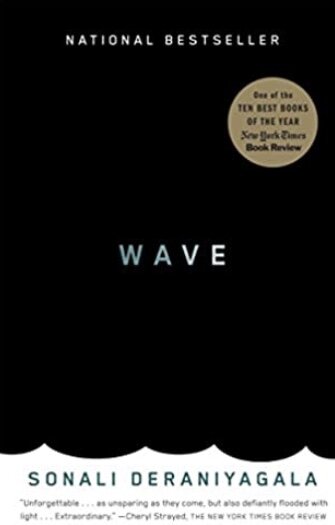Wave by Sonali Deraniyagala (Knopf)
On the day after Christmas, 2004, Sonali Deraniyagala is chatting with her friend at a Sri Lanka beach resort. Her husband is in the bathroom and her two sons are absorbed by their Christmas presents. Suddenly her friend looks out at the sea and says. “Oh my god. The sea’s coming in.” The two women watch as waves grow larger and come closer. They call to their families and then they all run.
A jeep moves by, stops, and picks them up but the water finds them, filling the interior of the vehicle until it reaches their chests. The jeep turns over.
Sonali is alone, spinning, within the wave, feeling crushing pain, her chest hurting as if it’s “being pummeled by a great stone.” Time moves slowly enough that she pinches herself on the leg to wake herself up, hoping that she’s dreaming. Her head finally moves above the water and she begins to float, a screaming boy beside her. She looks to see if he’s her child. He’s a stranger and she puts him out of her mind. When she sees a tree branch above her, she grabs it and her feet touch solid ground in “an immense bogland,..a knocked-down world.”
She wonders if it was the “end of time,” which it is, for her. From the beginning she knows her husband and children are dead. She berates herself for not warning her parents before she and her husband ran away to save their sons. She feels disconnected from everyone she sees, from other survivors at a hospital to her brother andf his family when she returns to Columbo. She wants to die and knows that as soon as she has the strength, she will kill herself.
Her relatives stick by her side. Friends come from her home in England. She lives in agony, wondering why she and her husband had insisted that their children have two homes in the world, England and Sri Lanka. This now gives her two countries where she encounters all that they longer share.
When her brother empties the home of their parents and rents it to a Dutch family a year after the wave, Sonali begins to haunt it. She pounds on its gates every night, telephones the tenants at two in the morning, rings their doorbell, immediately leaves and then comes back to do it again. Without peace herself, she refuses to give the right of living in peace to these strangers who have invaded her past.
When she returns to England, the life she used to have with the dead people she loves still fills the house they lived in. Ordinary objects pierce her wherever she looks and when her academic career as an economist offers her the chance to live in New York, she grabs it with the same savage desperation she had used to clutch the tree branch while engulfed in the wave.
It’s not until she returns to the Sri Lankan beach where she and her family were last together that she can look at the past without being stabbed in the heart. The eagles that her oldest son loved to watch are still there. When she ventures out onto the sea on a whale-watching expedition, the blue whales that fascinated her son come to the boat and Sonali sees “burst after burst of glowing blue,” the immensity of a tail breaking through the water. One of the whales comes close enough that she can hear it breathe; she believes it releases “a doleful sigh.”
Her memories no longer cut through her with jagged edges. “I can only recover myself when I keep them near,” Sonali realizes. With deep generosity and great love, she has turned her vanished life into art and her pain into a terrible and blinding knowledge that all of us are afraid of, that all of us, she says, would be able to survive.~Janet Brown
